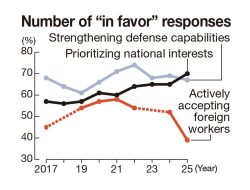
12:06 JST, September 4, 2022
If King Kong were to visit New York today, he’d hardly recognize the place. The 381-meter Empire State Building, once the tallest building in the world, is now merely the seventh tallest in Manhattan.
The evolution of the skylines of New York, London, Singapore and other cities is described by architect Stefan Al in his book “Supertall.” The title is a term of art, defined by the Council on Tall Buildings and Urban Habitat as a building over 300 meters in height. Al writes that there were only four such buildings on Earth in 1996, but now the planet bristles with nearly 200 of them.
Abeno Harukas in Osaka, not mentioned in the book, is currently the only Japanese building to reach 300 meters. But Al’s history of how buildings got so tall will have you looking at even less dizzying towers with a more informed eye.
The Empire State Building was constructed around a steel frame, which made it sturdy enough for Kong to climb. But all those steel beams take up a lot of interior space.
Al describes how engineer Fazlur Khan opened up that space with his “tubular frame” design, which put the building’s main support structure on the outside. This can be seen in Chicago’s 100-story John Hancock Center (now officially named 875 North Michigan Avenue), whose crisscrossing beams form gigantic X’s on its facade.
Later, engineer Bill Baker put the support structure back inside, in a compact form called the “buttressed core.”
“Three triangular buttresses supported a hexagonal core like an upright missile supported by its three wings,” Al writes. “This tripartite plan … is more stable, similar to a tripod holding a camera.”
The 830-meter Burj Khalifa in Dubai is a buttressed core building, but it also owes its current world’s-tallest status to a less glamorous technology. Instead of steel, its core is made of reinforced concrete — a surprisingly interesting substance. One chapter of “Supertall” traces the history of concrete from ancient Rome to the present day. Modern concrete is stronger than the Roman kind, but theirs was longer-lasting.
There’s also a chapter on air conditioning, which enabled large buildings to abandon the T- or H-shaped footprints that ensured no one was too far from a window. Another chapter covers elevators, a field in which several Japanese companies have broken one another’s speed records — although Al cautions that elevator speeds are now nearing the limits of bodily comfort.
The latter half of his book focuses on broader issues of city planning, such as mass transit and the human need for urban greenery.
A New York zoning law from 1916 aimed to prevent tall buildings from creating deeply shadowed urban canyons by requiring the outer walls of their higher floors to be set back from the street. This resulted in a tiered “wedding cake” look for many buildings, and is why the Empire State Building’s many ledges afford such ape-friendly handholds.
Recently, some developers have amassed transferable air rights to build “ultra-skinny” buildings in Manhattan. An example is “111 West 57, an 84-story skyscraper [that] is the world’s tallest and most expensive condo building. It has the proportions of a pencil: it’s a whopping twenty-four times taller than it is wide.”
It’s unlikely that Kong would want to climb such a thing, as ultra-skinnies sometimes “sway in the wind like reeds.”
Whether or not a giant primate ever sets foot in a big city again, plenty of ordinary people will. “By 2050, 2.5 billion more urbanites are projected to be living in cities. In addition to new housing, this urban drive will require a massive increase of city infrastructure.”
So, there are many big construction projects ahead. Considering that promoting infrastructure exports was presented as one element of Abenomics, Japan is likely to play a role in those projects. “Supertall” offers some ideas of what they will look like.

Supertall
- By Stefan Al
- W.W. Norton & Co., 296 pages, $30
"Culture" POPULAR ARTICLE
-

Dior, Gucci Adapt Kyoto’s Traditional Textiles for Modern Tastes
-

Event Held at Kyoto State Guest House to Showcase Beauty of Traditional Japan, Includes Crafts, Cuisine, Performances
-

Van Cleef & Arpels Dazzles with Art Deco Artisanry at Tokyo Exhibit
-

Ainu Thanksgiving Festival to Be Held in Tokyo with Performances from Ainu, Other Indigenous Groups
-

Disney’s ‘Twisted-Wonderland’ Animated Series Puts Villains in Spotlight: New Show Features School Inspired by Classic Disney Films
JN ACCESS RANKING
-

Govt Plans to Urge Municipalities to Help Residents Cope with Rising Prices
-

Japan Resumes Scallop Exports to China
-

Japan Prime Minister Takaichi Vows to Have Country Exit Deflation, Closely Monitor Economic Indicators
-

Japan to Charge Foreigners More for Residence Permits, Looking to Align with Western Countries
-

JR East Suica’s Penguin to Retire at End of FY2026; Baton to be Passed to New Character























